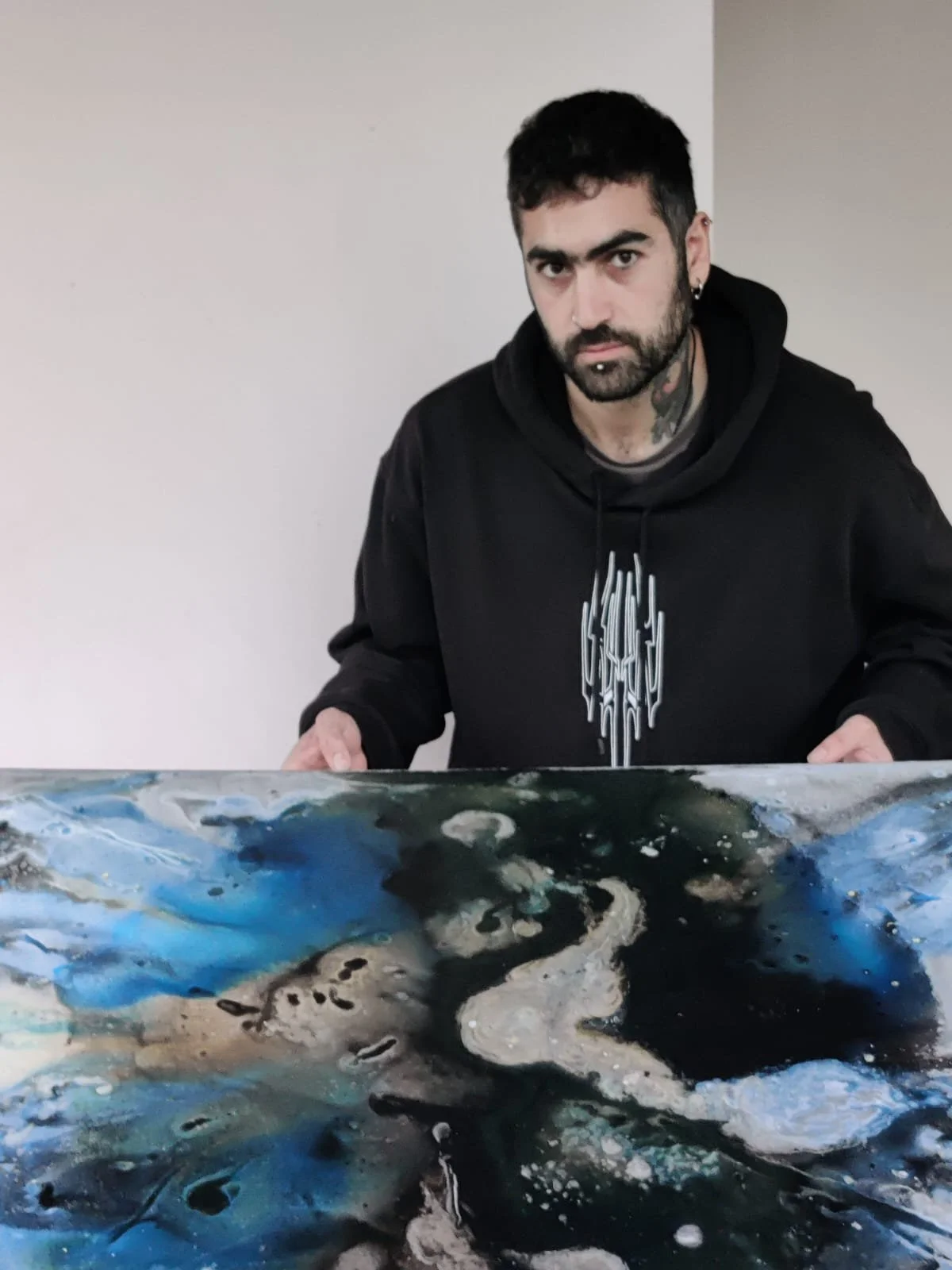10 Questions with Zhuo Xiong
Zhuo Xiong (b. 1988, Inner Mongolia, China) is an artist based in Shenzhen, China, and New York, US. He has a BFA from Guangzhou Academy of Art and an MFA in painting from the Royal College of Art, UK. Growing up as a minor ethnicity in China, in the nomadic area during the assimilation policy was implemented, Zhuo has been deeply influenced by the nomadic lifestyle and Mongolian traditions while torn by the drastic urbanization and cultural assimilation. His work is rooted in this cultural backdrop, with constant mediating in-between materials intrinsic to the pastoral lifestyle, such as felt, mineral powders, rabbit fur, sheepskin, cowhide, and milk. Zhuo Xiong's work has been exhibited in Shekou Gallery, Shenzhen; OM Gallery and Leo Gallery, Shanghai; Courtauld Institute of Art, London; LVS Gallery, Seoul.
Zhuo Xiong - Portrait
ARTIST STATEMENT
This series of works originates from the artist's reflection on his childhood. During his youth, Inner Mongolia underwent significant Sinicization, transitioning from a nomadic to a semi-nomadic, semi-agricultural lifestyle. Despite this shift, felt materials remained integral in daily life, repurposed into various household items and clothing. For the artist, felt became a medium to capture and reflect thoughts and traces of life.
The series is deeply influenced by the artist's perception of materials and his reinterpretation of art history. Using Manet's "Olympia," he creates fictional stories that critique contemporary issues. Growing up in a resource-poor, tightly controlled environment, the artist, a minority ethnic in China, sees parallels in historical events and figures, such as the fluctuating public opinion during the progression of modernism and the stigmatization of women like Victorine Meurent, Olympia's model. Art history, though often glamorous, merely beautifies transient moments.
For the artist, the pigment and casein in his painter's hands are, therefore, indistinguishable from the powders used across centuries by men and women to embellish their visages. The heavy fibre of felt scrupulously preserves painting traces, and its connection to daily life makes it an ideal medium to express complex emotions and demands.
Bas de Soie, Felt, casein, 56x36 inch, 2024 © Zhuo Xiong
INTERVIEW
Please introduce yourself to our readers. Who are you, and how did you become an artist?
I am Zhuo Xiong, a Mongolian-Chinese artist whose practice is deeply intertwined with my cultural heritage and personal history. I was born in Inner Mongolia, where I spent my early years living in a traditional yurt. My creative journey began as a way to process my experiences of displacement, cultural assimilation, and personal loss. Art became my means of storytelling—bridging the past with the present and reflecting on identity, memory, and survival.
You studied in both Guangzhou and London. How did these different environments impact your development as an artist and your approach to painting?
Guangzhou provided my foundational training in art, where I was immersed in Chinese painting techniques and academic approaches to representation. The structured nature of my studies there instilled in me a deep respect for materiality and craftsmanship. In contrast, my time in London exposed me to a more conceptual and interdisciplinary way of thinking. The city's dynamic art scene encouraged me to break away from traditional forms and explore new materials, performances, and installations. These contrasting experiences shaped my practice, allowing me to navigate between tradition and experimentation.
Corset, Felt, casein, 56x36 inch, 2024 © Zhuo Xiong
Dentelle, Felt, casein, 32×24 inch, 2024 © Zhuo Xiong
Your upbringing in Inner Mongolia during cultural assimilation has also significantly influenced your work. How did this experience shape your artistic vision and themes?
Growing up in Inner Mongolia during a time of cultural assimilation meant witnessing the gradual erosion of traditional Mongolian ways of life. My family and community faced pressures to conform to dominant cultural narratives, and as a result, I often felt caught between two worlds—one deeply rooted in nomadic traditions and another shaped by modernization. This duality is a recurring theme in my work, where I explore concepts of belonging, memory, and resistance. By using materials and imagery connected to my heritage, I seek to reclaim lost histories and create a dialogue about identity in flux.
Your work is deeply rooted in nomadic traditions and materials like felt, rabbit fur, and sheepskin. What drew you to these materials, and how do they help convey your artistic message?
These materials are more than just artistic choices—they are physical connections to my origins. Felt, rabbit fur, and sheepskin are essential elements of Mongolian nomadic life, used in clothing, shelter, and rituals. Working with them allows me to preserve and reinterpret the tactile essence of my heritage. The softness and warmth of these materials contrast with the often painful themes in my work, creating a tension between comfort and displacement. They also carry a sense of resilience, symbolizing the adaptability of nomadic cultures in the face of external pressures.
Felt appears as a recurring medium in your work, tied to both your heritage and daily life. What makes it particularly meaningful for you, and how do you explore its potential in your art?
Felt is one of the oldest textiles in human history, and in Mongolian culture, it is vital to survival—used in constructing yurts, clothing, and even ceremonial objects. It holds memory within its fibres, absorbing the physical touch of its maker. In my work, felt acts as both a canvas and a sculptural medium, allowing me to build layers that echo the layered nature of history and identity. I experiment with burning, cutting, and stitching the material, transforming it into something that speaks to both personal and collective narratives.
Mouche, Felt, casein, 56x36 inch, 2024 © Zhuo Xiong
You reinterpret art history, such as your engagement with Manet's "Olympia." How do you connect historical narratives with contemporary issues in your work?
Revisiting historical artworks allows me to question dominant narratives and reframe them through a new lens. Manet's Olympia represents a pivotal moment in art history, yet it also embodies colonial gazes and power dynamics that persist today. In my reinterpretation, I explore how the depiction of the body, gender, and race continues to shape contemporary visual culture. By integrating my own cultural references, I create dialogues between past and present, challenging inherited perspectives and offering alternative viewpoints.
How do you navigate the balance between the aesthetic appeal of your works and the complex, often challenging themes they address?
For me, beauty is a tool of resistance. Many of the themes I explore—displacement, loss, cultural erasure—are heavy, but I believe in the power of aesthetics to draw people in and create space for difficult conversations. The tactile, organic quality of my materials invites intimacy, making the narratives more personal and relatable. I don't seek to shock; rather, I aim to engage audiences emotionally, allowing them to discover meaning through texture, form, and symbolism.
Exhibiting in diverse cultural contexts, from Shenzhen and Shanghai to London and Seoul, how do you adapt or refine your work to resonate with audiences in these different settings?
Each exhibition context brings a different set of cultural references and expectations, so I approach every show with a sensitivity to its environment. While my core themes remain consistent, I adapt elements of my work to create meaningful connections with the local audience. In China, for example, I emphasize historical and philosophical aspects of my materials, while in the West, I often highlight their political dimensions. Rather than altering my message, I find ways to translate it effectively across different cultural landscapes.
Parfum, Felt, casein, 56x36 inch, 2024 © Zhuo Xiong
Perruques, Felt, casein, 56x36 inch, 2024 © Zhuo Xiong
Looking ahead, what new themes, materials, or projects are you excited to explore in your future practice?
I'm currently expanding my practice into performance and installation, incorporating sound and movement to further engage with nomadic traditions. I'm also researching ancient Mongolian textile techniques, exploring how they can be reinterpreted in a contemporary context. Themes of environmental displacement and resource scarcity are becoming increasingly relevant to my work as I see parallels between historical nomadic survival strategies and today's global challenges.
Lastly, what is your main goal or dream for 2025?
My main goal for 2025 is to create a large-scale, immersive installation that brings together painting, sculpture, and performance, offering audiences a deeper experience of nomadic culture and its relevance today. I also hope to collaborate with indigenous and migrant communities, fostering cross-cultural exchanges that highlight shared struggles and resilience. Beyond my own practice, I want to continue building platforms that support young immigrant artists, ensuring their voices and stories are heard.
Artist’s Talk
Al-Tiba9 Interviews is a promotional platform for artists to articulate their vision and engage them with our diverse readership through a published art dialogue. The artists are interviewed by Mohamed Benhadj, the founder & curator of Al-Tiba9, to highlight their artistic careers and introduce them to the international contemporary art scene across our vast network of museums, galleries, art professionals, art dealers, collectors, and art lovers across the globe.





















